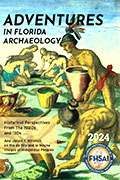See that one word, “Angola” in the second entry under “Situation” by “Oyster river”?
That one word in this 1832 U.S. government document is about the only official recognition of the existence (until 1821) of a settlement of 750 or so people near the mouth of the Manatee River (then the Oyster River) in southern Tampa Bay. The area is now Bradenton.
That early settlement was known as a maroon settlement - another word with a big story. Maroon may invoke a color, or thoughts of a ship-wrecked person stranded on an island, but in this case it comes from the Spanish term for “runaway.” The settlers were, for the most part, escaped slaves from Georgia and the Carolinas, encouraged by the Spanish to come to La Florida, pledge allegiance to the Spanish Crown, perhaps join the Spanish militia, and in any case, live free and populate the mainly empty colony.
There were several such communities around the state. As early as the late 17th Century the Spanish wanted to populate Florida and weaken the economic strength of the English plantations to the north. The route to freedom for slaves did not only run to Canada.
The Manatee River settlement named “Angola,” perhaps because that was the origin of many of the former slaves, was formed around 1812, during the war when the English wanted to regain control of Florida. That didn’t work out for the English, and after the war Spain, distracted by wars in Europe, lost control to the Americans in 1821. Immediately the U.S. government, mainly in the form of Andrew Jackson, set about making Florida attractive for white settlers. To put it simply, the settlement of Angola was destroyed by American soldiers and mercenaries. The settlers who were not killed were returned to slavery. Some of those who escaped death and capture appear to have made it around the Florida peninsula, located some ships, and escaped to the Bahamas. More on the modern consequence of that later.
Although the government and the military could act with impunity against runaway slaves, the longer established landowners, especially those of European heritage, required a bit more legal finesse. Congress came up with a plan where individuals making a claim to land had to provide copies of documents and statement from witnesses able to testify that the individual occupied the land before the U.S acquisition. Needless to say, escaped slaves, living in a remote part of Florida, never would have been able to meet the requirements, even if they had been given the chance. It didn’t do the other non-Anglo landowners much good, either.
This 1832 document in the collection of the Library of Florida History is a report from the Secretary of the U.S. Treasury on private land claims in East Florida.
The finding on the claim from Joseph Maria Caldez, a Cuban fisherman who had long settled on an island near the mouth of the Manatee River, near the community known as Angola, shows how laws enacted in distant Washington, D. C. played out on the ground.
Like so many vanished and minority communities, Angola is under-represented in Florida’s history.
However, even a trace can spark the interest of historians, and since 2004 an interdisciplinary group of scholars, archeologists and anthropologists have been looking for Angola: (http://www.lookingforangola.org/.)
A historical marker has been placed in Bradenton’s Mineral Springs Park near a fresh water spring the experts think was the settlers’ source of drinking water.
Thanks to recent research, Dr. Uzi Baram of the New College of Florida and his students have created a video of what they think the settlement looked like: https://youtu.be/M8rzjn8w7XY
What of those rugged folks who walked around the state and eventually made it to boats at Cape Florida?
Their descendants can be found living today at Red Bays on Andros Island in the Bahamas.

In July, 2018, some came back to Bradenton for a festival at the site where their ancestors were deprived of a chance to live free.











